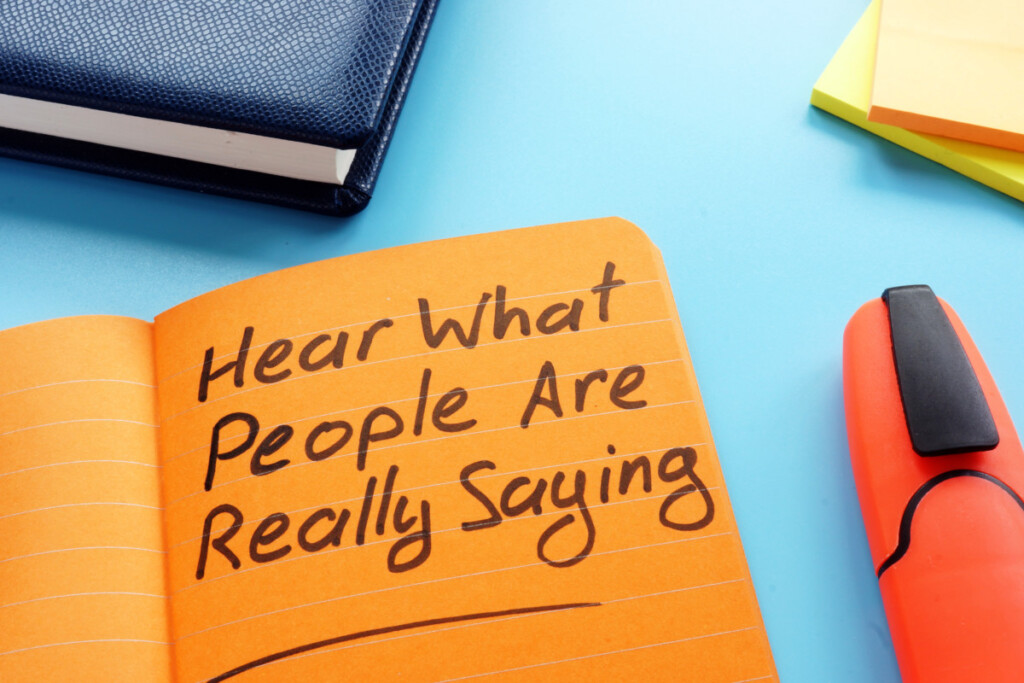Communication is the glue of life. The biggest struggle with communication is that we don’t know how to go about sharing our thoughts and feelings in the best way possible. Whether you are looking to improve a romantic relationship or get more sales leads, it’s essential that you know how to communicate.
What are some ways to improve your communication skills? The 15 ways to improve your communication are:
- Focus on Meaning
- Don’t Over-Plan What You’ll Say
- Practice Talking Out Loud
- Understand What Emotions You’re Sharing
- Repeat What They Said
- Give Time to Agreements
- Follow Up
- Wait to Respond
- Pay Attention to Their Tone
- Ask Questions
- Learn to Say “No”
- Focus on Eye Contact
- Notice Their Hands
- Mimic Their Bodies
- Keep Their Bodies Open
In a world with over 6,500 languages, you can still do your best to improve your communication skills with some practical tips. The most effective way to improve your communication is to focus on the meaning and express your message beyond the words you’re stating. It is a practice, so the more exposure you get, the better you will become. Communication is so much more than just swapping statements. It’s words, body language, timing, situation, setting, and more.
It can be overwhelming to imagine all of the ways that you might have to communicate with someone. You might struggle to express your words or get the other person to truly understand what you’re trying to say. In this post, we’ll help you explore the best methods for having the most effective communication possible.
The Importance of Communication

Communication can help you with anything in life. Ever wonder how some people are always so lucky? Always getting discounts, making new friends, and hearing about exciting news first? It’s not always luck; sometimes it’s just how we manage to exchange words back and forth with others! The main benefits of being an effective communicator are:
- Share your true thoughts
- Achieve your goals
- Express your feelings
- Resolve conflict
- Persuade others
Most of us are already aware of why communication is so important. One thing that’s less focused on is how to actually do it! Figuring out what other people are thinking can be a challenge. Just look at this chart. I’m sure you can relate to some of these phrases and you’ve almost definitely heard someone say one of them before:
| What They Say | What They Mean |
| Maybe | No, but I don’t want to say no just yet. |
| We should get together soon | I’m trying to end this conversation on a happy note, but I have no plans of getting together. |
| That is so interesting | I don’t really know what else to say right now but I don’t want to be rude. |
| I’m running a little late | I literally just left my house so I will be extremely late but will come up with a second excuse by the time I get there. |
Try creating your own chart of what you say and what you really mean. You will see that you are likely participating in hidden meaning speaking. To really get your message across, it’s important that we focus deeply on what we are trying to say. This, among other tips mentioned throughout, will help you to be the best communicator you know.
Tip #1: Focus on Meaning
The most important thing that you will do when you’re communicating with another person is to share a message with them. No matter what words or phrases you say, they’re going to walk away with their own perspective of the message. You can tell two people the exact same thing and they can each take it a different way.
To have effective communication, you want to break it down to the very core. You want to find the meaning that you are attempting to pass along from one individual to the next so you can ensure they are taking the right message away.
When you are communicating with different people, you might want to talk to them in a way that they understand. Consider the context of the situation. If you are telling somebody that you are stressed during a situation where they are anxious too, they might not take you as seriously because they too are feeling the same way.
If you tell somebody you are stressed when they are calm, they can be more attentive and listen to your needs. The same message can have different meanings depending on the situation.
Rather than starting with a message and then trying to pull the meaning from that, focus on the meaning first.
Tip #2: Don’t Over-Plan What You’ll Say
When we focus too much on the actual words we want to say, when they eventually come out, they can be jumbled and messed up. It can make the listener confused and you can get hung up on missing a certain phrase or saying. Rather than doing that again, as we said in the first tip, pay attention to the overall meaning.
When it comes time for you to give a presentation in front of a bunch of people and you have a speech to give, you’ll want to make sure that you are not reading from a script verbatim. Instead, have note cards with major talking points to try and make sure that you stick to the most important messages at that moment.
You can take notes on many different things as well. Take a list of your symptoms to the doctor’s office. Many doctors say that their patients will ramble on about things that have nothing to do with their health because they just come in and start talking about things unrelated to the reason they came in for. List specific symptoms on a notecard so that when you talk to your doctor, you can effectively tell them the most important information they need to properly diagnose you.
When you are having a discussion with a spouse, a coworker, or a family member with whom you’re trying to improve a relationship, don’t be afraid to also have a little note card with a few talking points.
You don’t want to have a strict script where you have to read every sentence word for word, but having those major bullet points can give you the confidence needed to effectively get your message across.
Tip #3: Practice Talking Out Loud
Effective communication is only built through practice. One of the best ways to do that is to practice talking out loud. Not only is this to work through any kinks in your speech but also to build that confidence within yourself.
Sometimes, it can be very scary to begin talking to others because we don’t really recognize our tonal shifts and how we are speaking. Practice talking in front of the mirror, pay attention to how your face might change shapes or expressions, and how you use your hands.
You might notice when you’re talking about something serious that you begin to furrow your brows, making you look angry. Maybe you don’t want to look angry at all so you can be more conscious of this when you’re spreading your messages to others. Again, don’t practice verbatim what you’re going to say, but getting used to your voice and talking out loud can do wonders for improving your communication skills.
Reaction Versus Response

Your reaction is the immediate feeling or emotion you have to new information that someone has shared with you. The response is the way that you choose to handle this emotion. If someone says that you are dumb, you’ll likely react by being hurt or offended. The response is what would vary. You could tell them they too are dumb, or you could respond by walking away and ignoring them. It isn’t always easy to manage that response, so we’ll help you better differentiate for effective communication in this section.
Tip #4: Understand What Emotions You’re Sharing
Communication is all about spreading emotions. Whether you’re crying to a friend about how upset you are, or you are showing gratitude and appreciation to a boss, you will be showing them your emotion.
When communicating, make sure that you pay attention to how you’re feeling and how that is going to be demonstrated to the other person. If you are actively angry while speaking to somebody, they could pick up on that emotion if they can hear it in your tone. Take the time to recognize how your thoughts and feelings are being spread to other people and try your best to contain those emotions and use them to spread a message effectively so that they don’t cloud the conversation and cause any mixed messages.
Tip #5: Repeat What They Said
It can be easy to hear what somebody said and automatically want to react. They might have chosen poor words or you misinterpreted their message to the point that you can’t give a proper emotional response back.
Maybe they said something ignorant or rude and it makes you want to immediately come back at them in a defensive way. First, repeat back what they said to you. When you do this, it might help them realize that what they said came out incredibly wrong. Repeating back what they said also helps you to better comprehend the message that they’re saying. This isn’t just useful for a negative situation where somebody might be getting defensive either.
Perhaps you were going through with a business negotiation at work. You want to repeat the original message back to your colleague so that they are aware of any details that may have been missed. Put the words back in somebody else’s head from a new perspective so they hear what they really said. They can cater their communication to you so that everybody properly understands what is being discussed.
Tip #6: Give Time to Agreements
Don’t feel pressured to immediately come to a conclusion with every conversation you have. It can be very challenging to walk away when some things are open-ended, especially if you are negotiating or even having an argument with somebody. However, if you are too quick to come up with a conclusion, then you might miss out on more important options that would be discovered through reflection.
Next time you have to come to an agreement, first consider if more time is a possible option. Even if you’re in the middle of a heated argument with your spouse, tell them that you need a break and you want the both of you to reflect for at least 30 minutes before coming back to each other with a response. It doesn’t have to be days or weeks of consideration. Sometimes, a few minutes can help give you clarity. Simply removing yourself from that situation and walking away to another room can be enough to give you the best answer possible. If we’re too quick to answer, we risk jumping to the wrong conclusions and solutions to a problem.
Tip #7: Follow Up
After having a conversation with somebody, it can be effective to follow up with them. Touch back in to see if anything wasn’t covered the first time, and to see if anything has changed since. You can do this both in a personal and professional setting.
If you had an argument with a friend, you can check in with them after a few days and say, “I want to make sure that everything is okay and if there’s anything else you want to talk about, let me know.”
The worst that could happen is that you fight all over again. But that shows that the conversation has ended anyway. There were still issues that needed to be addressed.
Follow up in a professional setting as often as possible. This is how you will build strong connections with others and further your career.
If you’re interested in finding out more about how to follow up in a business setting, especially with sales leads, this is a great watch:
Listening is Key

Communication isn’t just about what you are sharing with other people. It’s also important to take in and evaluate the thoughts and ideas they are giving to you. Listening is half the work, so in this section, we’ll help you improve your communication by opening up your ears.
To get even deeper into this, check out some of the important aspects of being a good listener, as discussed in this video:
Tip #8: Wait to Respond
Many conversations don’t involve two active listeners. Too frequently it’s one person talking and the other person planning out what they’re going to say next. When you are having a conversation with somebody, it is essential that you do your best to actively listen to the things that the other person is sharing.
You don’t want to just come up with a response to try to prove why you are right and they are wrong. Conversations are not competitions. It’s about two people sharing messages to grow and get to something deeper and more important.
In the end, proving that you are right is not going to do anything to benefit you. It’s just going to make the other person feel bad or they will just get more defensive. Be mindful when you’re having a conversation with another person.
If you notice that you’re getting stuck in your head and going over and over the things that they’re saying, pay attention to their faces. Don’t trail off and zone out while they’re talking. Look them in the eyes or look at their mouths. See the wrinkles in their faces to know which muscles are being used.
Are they frowning? Are they furrowing their brows? Are they expressionless? Pay attention to their hands and even their feet. Your feet can tell just as much about what you’re trying to say as your hands can.
Sometimes, our feet can reveal a lot about what we’re thinking because we’re less conscious about controlling these parts of our body.
Repeat back what they said. Ask them more questions and let them speak their truth; you will have your turn.
Tip #9: Pay Attention to Their Tone
Pay attention to tonal shifts when you are communicating. This way you can cater to the mood the other person is in, whether they are upset or they are happy. Sometimes, tone can be misinterpreted, so it will take a bit of practice in order to really understand different tonal shifts. Try saying the phrase below in five different ways:
- “That is so interesting.”
It’s a simple phrase that could have several different meanings. Practice saying it in these four different tones:
- Enthusiastic
- Curious
- Sarcastic
- Angry
You can see for yourself, from doing this simple activity, that tone can sometimes be much more important than the phrase itself. The phrase said enthusiastically shows that the person is legitimately interested. A curious tone might be used if two people were having a deep discussion. Sarcastic tones can be referring to a situation that’s boring. Angry tones can indicate someone having an argument or angry discussion.
“That is so interesting,” is just an arrangement of words—the tone tells the story.
Tip #10: Ask Questions
Asking questions is one of the most effective ways that you will be able to further communication between you and another individual. Not only does asking questions get them to express the deeper meaning of what they are saying further, but it also gives you the chance to have a moment to think to yourself what else you want to talk about.
Asking questions can take the morsel of truth they’ve given you, and you can then break that open to find something more valuable inside. If we overlook the tone of somebody’s voice, we might be completely missing a hidden message that they are trying to share.
Asking questions will also show the other person that you are actively listening to what they have to say. You can redirect the conversation in this way, and you can present greater phrases, without doing so as an attack.
For example, you might want to say to somebody, “You sound crazy. I have no idea what you mean.” That can create a defense and make them feel bad.
Instead, you could say, “I’m having trouble understanding your perspective. Do you think you could explain that a little further for me?” You’re keeping things in a more civil tone so that the true intention can come through, rather than it is a war between two voices.
Tip #11: Learn to Say “No”
Many individuals will struggle with their ability to say no. Saying no can be incredibly powerful. It gives you the opportunity to speak your truth and make sure that your voice has been heard.
When it comes to saying no and standing up to others, you want to make sure you are practicing how to respond in a few different ways. Here are a few different ways of saying no:
- Maybe some other time.
- Thank you for the opportunity but I can’t at the moment.
- I appreciate the chance but I can’t right now.
- I have too many other commitments or else I would.
A simple “no,” “nope,” and “definitely not,” are totally justified as well. Never feel pressured to give an excuse—simply say “no!”
Understanding Body Language

You can send more messages with the way that you choose to sit than you sometimes can with your words. Body language cannot be overlooked when we start to explore the way that we are sharing messages with other people. Let’s explore a few ways that you can improve body language so you have more effective communication.
Tip #12: Focus on Eye Contact
Eye contact is incredibly important to consider when you are communicating with somebody else. Your eyes are the way that you will glue yourself to them and pull them in so that they really hear what you’re trying to tell them. Don’t overdo the eye contact to the point that you are staring them down and making them uncomfortable. Ensure that you take a moment to lock eyes while they are talking to show that you are actively listening.
Tip #13: Notice Their Hands
The hands can tell you a lot about what the other person is saying. You also have to focus on how you are using your hands to let them know whether or not you’re being honest with them. You can better enable yourself to grab their attention using your hands.
You want to talk with your entire body, not just your mouth. For this reason, your hands can be like the conductor, helping to move your body altogether. If you notice that you are feeling very scared or lacking self-esteem when speaking to somebody else, start using your hands.
Of course, you don’t want to smack people across the face on accident or knock things over, but begin lifting your hands, and at least open or close them once to start to elicit those kinds of feelings. Know that when you hide your hands from other people, it can seem more untrustworthy.
If your hands are tightly closed together or are placed on your lap, it can also make you look as though you are more closed off.
Tip #14: Mimic Their Bodies
One thing you can do for better communication is to mimic the other person’s body language.
When you mimic somebody else’s body language, it’s like a mirroring act that helps them see themselves in you. They’ll be more open and trusting of the things that you have to say. Pay attention to how somebody else mimics your body language as well.
Sometimes this is just a nervous tick we do because we might be anxious within a conversation. Other times, you can tell if they are trying to get on your good side, persuade, or convince you by the way that they are matching your body language.
If you’re really interested in getting to know more about body language and whether or not you can trust someone, check out these tips on how to tell if someone is lying just through their body language:
Tip #15: Keep Their Bodies Open
Transitioning into this tip from the last, mimicking someone’s body language can help them to open up more if they are already seemingly closed off.
Imagine someone is sitting in front of you with their arms crossed. You can sit in the exact same way. After a few moments of this, open your arms and lean back. You’ll notice that they will likely do the same. Then, you can be more likely to persuade them or at least have them actively listen to the things you’re sharing.
If they are harder to get to open up, you could even hand them something to force their arms to relax and have them open up. It is a practice, so the more you do this, the better you will become.
Related Questions
Communication can be tricky to understand, so it’s not a crime if you have more questions about how to talk effectively. We have a few more questions and answers to help you better understand how to make the most of the words you’re sharing.
How can I be more confident when speaking?
Confidence can certainly help make communicating easier, so you’re likely wondering what the best method to boost your self-esteem might be. Remember that communication is something that needs to be practiced, so look for ways to talk as much as possible. Try talking to yourself in a mirror to help you boost your confidence. You’ll still make mistakes, but the more opportunities you give yourself to improve, the easier it will be to share what’s on your mind.
What’s the worst thing you can do when communicating?
Nothing you do when communicating will be that bad, but there are some things you should strive to avoid. The worst thing you can do when talking to someone else is failing to listen to what they’re trying to say. You will either miss the message or misinterpret something that gets taken the wrong way. No matter what you might do or say when communicating, don’t forget to listen to what the other person is actually saying.
